Aiming to take advantage of the growing global demand for small, high-mileage vehicles, Smart has unveiled two long-awaited offerings: a replacement for its pint-sized Fortwo model and an all-new four-seater, appropriately dubbed the Forfour.
The pair come to market as the culmination of an expanding affiliation between Smart’s parent Daimler AG and the Renault Nissan Alliance. The French-Japanese partnership has already launched its own version, the Renault Twingo having made its debut during the Geneva Motor Show earlier this year.
While sharing many key, underlying components, the partners emphasized developing different visual designs, with Daimler’s Smart brand also opting for two different interior configurations. The maker is hoping to sharply increase global sales by offering both two- and four-seat models, though there are currently no plans to bring the Smart Fortwo over to the U.S. market.
“Smart is a radical and revolutionary idea,” said Daimler CEO Dieter Zetsche, during a Berlin unveiling, “ideally suited to an urban environment.”
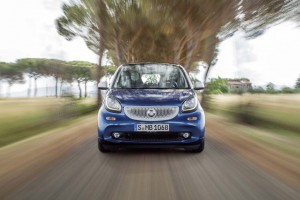
The basic shape remains largely the same, the grille the most obvious update to the 2016 Smart Fortwo.
Those familiar with the original Smart Fortwo will likely have to take a closer look to be sure they’re looking at an all-new version of the microcar. The 2016 model retains the basic, tall wedge shape and a nose-to-tail length of just 2.69 meters in European trim, or 8.83 feet. The Forfour adds another 0.8 meters, or 2.62 feet.
Both models stand 1.55 meters in height, or 5.08 feet, with a width of 1.66 meters, or 5.44 feet. Smart did not release specific details on mass but the maker emphasized efforts at cutting mass through its new design and the use of lightweight materials, such as the plastic door panels. The current Fortwo in U.S. trim starts at just 1,630 pounds.
Its short overhangs and rear-mounted engine make the two-seater especially maneuverable on city streets, able to turn a complete circle in barely 23 feet – several feet tighter than before, the company notes. The turning circle for the Forfour will be only about six feet wider.
“We have tailored both of the vehicles to the needs of modern-day city traffic,” suggested the Smart brand’s head of product development, Markus Riedel.
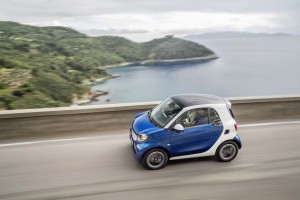
The new Fortwo and Forfour will have three gas engines available – and an electric drive version is likely to follow.
Daimler is putting significant emphasis on the safety aspects of the Smart design, perhaps no surprise considering the ongoing concern many potential buyers have expressed about the potential risks of driving such small vehicles alongside more conventional products weighing hundreds, even thousands of pounds more. Both models share the “tridon cell” safety shell, designed to absorb the shock of a crash and pass impact forces around the passenger compartment.
The original Fortwo was one of the first small cars to adopt electronic stability control – in part due to some embarrassing reviews that found stability issues under emergency maneuvers.
The new models will offer not only stability control and a full complement of airbags – including a new driver kneebag – but also an assortment of new features. That includes Crosswind Assist, a system designed to counter the impact of strong winds on the slab-sided vehicles. Optional gear includes a new Lane Keeping Assist system and Forward Collision Warning.
Visually, perhaps the biggest difference between old and new Smart Fortwo can be seen in the form of the honeycomb grille adapted from recent concepts such as the Smart For-us and Forstars.
Both models get more upscale cabins that adopt round and oval elements, including the curvaceous new dashboard. The Forfour gets significantly more cargo space, with even the front passenger seat able to fold down.
“If this isn’t urban joy, what is?” asked Smart brand boss Annette Winkler.
Along with various audio options, Smart plans to offer an app package that will allow buyers to add a number of features including Internet radio access, an affordable navigation program, even a feature that – where available – will let a driver find available parking spots, a real benefit in crowded cities.
Initially, Daimler had planned to pitch the Smart brand’s products as highly customizable, even allowing a buyer to mix and match the replaceable body panels. It didn’t quite work out as planned, but Zetsche stressed that the new model will be available with a total of 800 different configurations, telling his Berlin audience, “You can expect to spend long nights on the online configurator.”
Among the choices buyers will get to make, the two models will be offered with either a 66 horsepower three-cylinder engine, or a beefed up 71 hp version of the powertrain. Buyers will be able to choose either a new five-speed automatic or a new twin-clutch gearbox. The maker will add a 45-hp high-mileage package “a few months” after the November European launch.
(Smart offers tease of new Fortwo and Forfour models. For more, Click Here.)
Smart is expected to also add a new battery drive system at some point in the near future to replace the current Smart Electric Drive, or ED, model.
The new transmissions are expected to address one of the biggest complaints about the older model, its rough-shifting gearbox. But Smart has other challenges that it promises the 2016 remake will improve on, including the older car’s rough ride.
(Click Here for details on how the bounty for hacking the Tesla Model S has security experts worried.)
Smart sales have never come close to the maker’s expectations, especially in the U.S. But Zetsche suggested, “We’re aiming for more than just more market, but more city share. If Buenos Aires had the same share of Smarts as Rome, we’d have to open up a new plant.”
The Daimler chief executive noted that by 2025, about 280,000 new vehicles will be added to global fleets daily, and a significant share of those will go to increasingly crowded cities, such as Buenos Aires, never mind Beijing and Berlin.
(To see more about former Ford CEO Alan Mulally’s gig at Google, Click Here.)
The first of the new Smart cars will reach European showrooms in November, the Fortwo coming in at a starting price of 11,000 Euros, or $14,881 at current exchange rates. The Smart Forfour will add another 600 Euros, or about $900, to the base price.
Specific details for the American launch haven’t been released yet but, at least for the moment, Smart has hinted it will only bring the two-seat Fortwo to U.S. showrooms. The current starting price is $14,020.

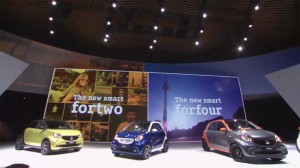
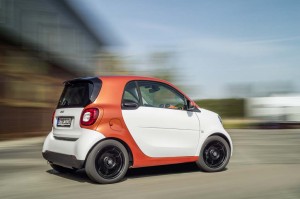
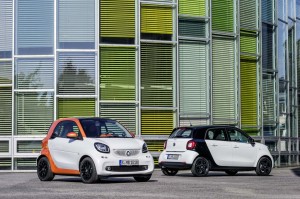
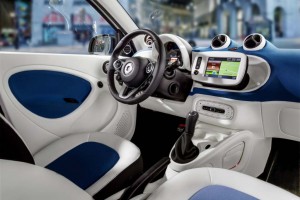
The Fortwo looks like an ugly bulldog on wheels, and very possibly a crash deathtrap!
The original Smart, despite its size, actually held up reasonably well in crashes, Turtle. And we expect the new one to be even better. We won’t comment on its looks.
Paul E.